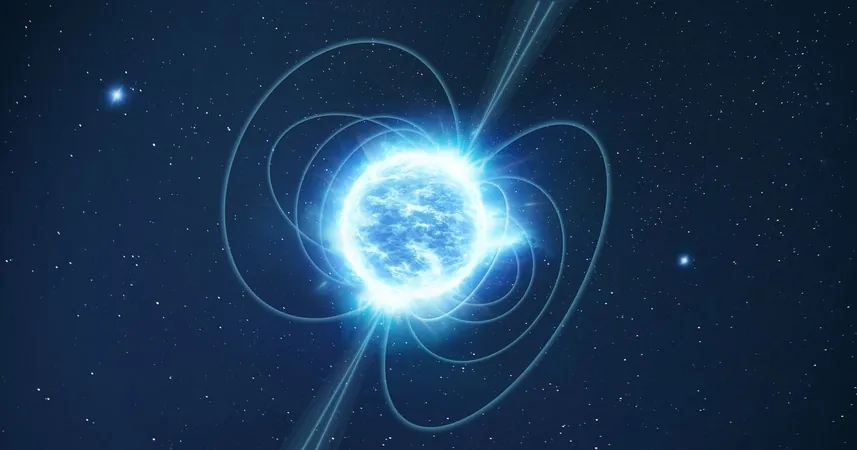
NASA's 'Zombie Star' Could Devastate Humans If They Get Too Close!
2025-04-28
Author: Emma
NASA Discovers a Deadly 'Zombie Star'!
An astonishing discovery by NASA has left scientists baffled: a neutron star, terrifyingly strong, has the potential to obliterate a human being if they venture within a mere 600 miles of it. This bizarre cosmic entity, known as SGR 0501+4516, is considered one of the rarest stars in the Milky Way, with only about 30 such stars existing in our galaxy of approximately 100 billion.
The Power of SGR 0501+4516!
SGR 0501+4516 boasts what NASA calls "comic-book-hero superpowers," featuring a magnetic field a staggering trillion times more powerful than Earth's magnetosphere. Scientists warn that if this star drifted close to Earth—even at half the distance to the Moon—it could potentially wipe out every credit card on the planet!
In the dramatic words of a NASA press release: "If a human got within 600 miles, the magnetar would become a proverbial sci-fi death-ray, ripping apart every atom inside the body." Imagine the consequences!
The Mystery Behind the Magnetar!
These enigmatic magnetars are thought to form from supernovae—massive explosions that leave behind ultra-dense neutron stars. Often dubbed ‘zombie stars,’ they raise fundamental questions in astrophysics. Ashley Chrimes, the lead author of the discovery published in *Astronomy & Astrophysics*, emphasized the uniqueness of magnetars because of their extreme magnetic fields.
Unraveling the Origins of SGR 0501+4516!
Originally spotted by the Hubble Space Telescope in 2008, SGR 0501+4516 was presumed to have formed from a nearby supernova. However, a decade-long observation revealed inconsistencies in this theory. It could either be significantly older than the estimated 20,000 years or born through a different process altogether.
Co-investigator Joe Lyman from the University of Warwick remarked, "All of this movement we measure is smaller than a single pixel of a Hubble image. The ability to make such precise measurements showcases the long-term stability of Hubble."
A Theoretical Birth!
Scientists propose that SGR 0501+4516 might have formed via a process called accretion-induced collapse. In this scenario, a white dwarf—remains of a sun-like star—accumulates gas from a neighboring star. Eventually, it becomes too massive to maintain its structure, leading to an explosion. Under certain conditions, instead of exploding, this white dwarf collapses into a neutron star.
Andrew Levan from Radboud University elaborated, "Normally, this scenario triggers nuclear reactions and results in an explosive end. However, it’s theorized that sometimes the white dwarf can collapse into a neutron star, and that might be how SGR 0501 was born."
Implications for the Universe!
The formation of magnatars like SGR 0501+4516 through such processes might also shed light on mysterious cosmic events, including fast radio bursts. Nanda Rea from the Institute of Space Sciences in Barcelona explained, "Understanding magnetar birth rates and formation scenarios is crucial in high-energy astrophysics. It could unravel mysteries concerning powerful cosmic events like gamma-ray bursts and superluminous supernovae."
Stay tuned as we delve deeper into the mysteries of the universe!









 Brasil (PT)
Brasil (PT)
 Canada (EN)
Canada (EN)
 Chile (ES)
Chile (ES)
 Česko (CS)
Česko (CS)
 대한민국 (KO)
대한민국 (KO)
 España (ES)
España (ES)
 France (FR)
France (FR)
 Hong Kong (EN)
Hong Kong (EN)
 Italia (IT)
Italia (IT)
 日本 (JA)
日本 (JA)
 Magyarország (HU)
Magyarország (HU)
 Norge (NO)
Norge (NO)
 Polska (PL)
Polska (PL)
 Schweiz (DE)
Schweiz (DE)
 Singapore (EN)
Singapore (EN)
 Sverige (SV)
Sverige (SV)
 Suomi (FI)
Suomi (FI)
 Türkiye (TR)
Türkiye (TR)
 الإمارات العربية المتحدة (AR)
الإمارات العربية المتحدة (AR)